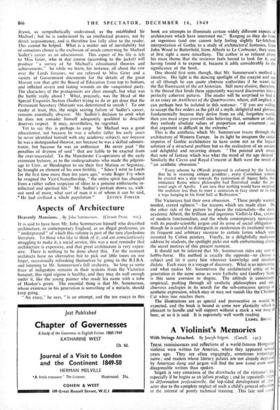Aspects of Architecture
Heavenly Mansions.. By John Summerson. (Cresset Press. a is.) IT is said to have been Mr. John Summerson himself who described architecture, in contemporary England, as an illegal profession, an " underground " of which this volume is part of the rare clandestine literature. To those who like to think of it, and are conscientiously struggling to make it, a social service, this was a neat reminder that i architecture is expensive, and that great architecture is very expen- sive. There is nothing to be done about this. For the moment architects have no alternative but to pick out little tunes on one finger, occasionally refreshing themselves by going to the R.I.B.A. and listening to Mr. Summerson's full orchestra. So long as some trace of indigestion remains in their systems from the Victorian banquet, this rigid regime is healthy, and they may do well enough under it, like the young painter who made his name with a tube of' Hooker's green. The essential thing is that Mr. Summerson, whose existence in his generation is something of a miracle, should keep going.
" An essay," he says. " is an attempt, and the ten essays in this book are attempts to illuminate certain widely different aspects of architecture which have interested me." Ranging as they do from an ingenious (and one cannot help feeling slightly far-fetched) interpretation of Gothic to a study of architectural fantasies, from John Wood to Butterfield, from Alberti to Le Corbusier, they seem at first sight a mere miscellany. The author is so reticent about his main theme that the reviewer feels bound to look for it, and having found it to expose it, because it adds considerably to the significance of the book.
One should first note, though, that Mr. Summerson's method is intuitive. His light is the dancing spotlight of the essayist and not at all (though he can quote abstruse authorities if he wants to) the flat fluorescent of the art historian. Still more elusive, therefore, is the thread that binds these apparently wayward discoveries into a perfectly coherent pattern. The reader will be surprised to find it in an essay on Antitheses of the Quattrocento, where, still implicit, it can perhaps best be isolated in this sentence: " If you are willing to accept the five orders as the gift of a myth, delightful and glorious fundamentally because they derive from an old, forgotten world, then you must argue yourself into believing that, somehow or other, they embody absolute values of proportion and ornament ; and that argument is difficult in the extreme."
This is the antithesis which Mr. Summerson traces through the architecture of Western Europe. In its light he imagines the initial impetus of Gothic architecture to have come not as the logical solution of a structural problem but as the realisation of an ancient and delightful and recurring dream. "The pointed arch struck that note of fantasy which was what the mind of the age desired." Similarly the Circus and Royal Crescent at Bath were the result of " an aesthetic obsession."
"Every scheme he (Wood) proposed is coloured by the feeling that he is restoring antique grandeur ; every Corinthian column he erected was a step towards the restoration of Aquae Sulis, that miniature Rome where philosophy had flourished under the per- sonal aegis of Apollo. I am sure that nothing would have surprisal the architect kss than to meet a centurion in Gay street or to find a toga hanging in his front hall at Batheaston."
The Victorians had their own obsession. "These people wanted, needed, craved ugliness "—for reasons which are made clear. On the other side of the picture he places the rationalists—the dour, academic Alberti, the brilliant and ingenious Viollet-le-Duc, creator of modern functionalism, and the whole contemporary movement with its pseudo-scientific jargon and its sense of social obligation- though he is careful to distinguish in modernism its irrational strain, its frequent and arbitrary recourse to certain forms which were invented by Cubist painters. Finally, in a delightfully malicious addreis by students, the spotlight picks out with embarraAing clarity the secret motives of this present moment. It should not be inferred that Mr. Summerson rides any sort of hobby-horse. His method is exactly the opposite—to choose a subject and let it carry him wherever knowledge and intuition dictate. Each essay is a voyage of discovery. What is so interesting. and what makes Mr. Summerson the architectural critic of ha generation in the same sense as were Lethaby and Geoffrey Scott, is this same aversion to dogma. The attitude is consistently empirical, pushing through all aesthetic philosophies and mis- chievous analogies in its search for the sub-conscious springs of aesthetic expression, which may or may not vanish like the Cheshire Cat when one reaches them.
The illustrations are as special and provocative as would be expected, and the book is bound in some new plasticity which is pleasant to handle and will support without a mark a wet mug of beer, or so it is said. It is supremely well worth reading. LIONEL BRET r.


































 Previous page
Previous page